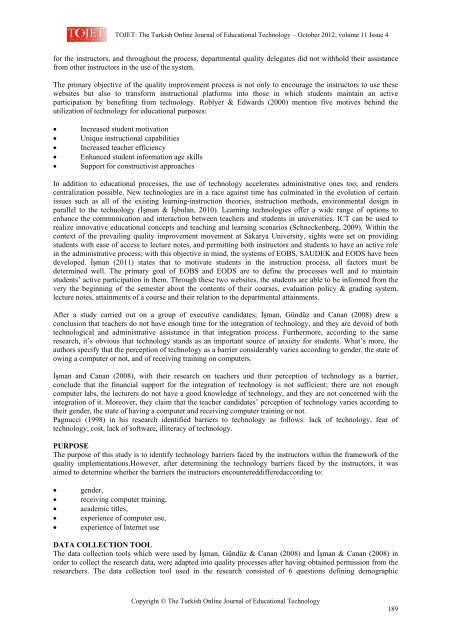october 2012 - TOJET the Turkish online journal of educational ...
october 2012 - TOJET the Turkish online journal of educational ...
october 2012 - TOJET the Turkish online journal of educational ...
Create successful ePaper yourself
Turn your PDF publications into a flip-book with our unique Google optimized e-Paper software.
<strong>TOJET</strong>: The <strong>Turkish</strong> Online Journal <strong>of</strong> Educational Technology – October <strong>2012</strong>, volume 11 Issue 4<br />
for <strong>the</strong> instructors, and throughout <strong>the</strong> process, departmental quality delegates did not withhold <strong>the</strong>ir assistance<br />
from o<strong>the</strong>r instructors in <strong>the</strong> use <strong>of</strong> <strong>the</strong> system.<br />
The primary objective <strong>of</strong> <strong>the</strong> quality improvement process is not only to encourage <strong>the</strong> instructors to use <strong>the</strong>se<br />
websites but also to transform instructional platforms into those in which students maintain an active<br />
participation by benefiting from technology. Roblyer & Edwards (2000) mention five motives behind <strong>the</strong><br />
utilization <strong>of</strong> technology for <strong>educational</strong> purposes:<br />
• Increased student motivation<br />
• Unique instructional capabilities<br />
• Increased teacher efficiency<br />
• Enhanced student information age skills<br />
• Support for constructivist approaches<br />
In addition to <strong>educational</strong> processes, <strong>the</strong> use <strong>of</strong> technology accelerates administrative ones too; and renders<br />
centralization possible. New technologies are in a race against time has culminated in <strong>the</strong> evolution <strong>of</strong> certain<br />
issues such as all <strong>of</strong> <strong>the</strong> existing learning-instruction <strong>the</strong>ories, instruction methods, environmental design in<br />
parallel to <strong>the</strong> technology (İşman & İşbulan, 2010). Learning technologies <strong>of</strong>fer a wide range <strong>of</strong> options to<br />
enhance <strong>the</strong> communication and interaction between teachers and students in universities. ICT can be used to<br />
realize innovative <strong>educational</strong> concepts and teaching and learning scenarios (Schneckenberg, 2009). Within <strong>the</strong><br />
context <strong>of</strong> <strong>the</strong> prevailing quality improvement movement at Sakarya University, sights were set on providing<br />
students with ease <strong>of</strong> access to lecture notes, and permitting both instructors and students to have an active role<br />
in <strong>the</strong> administrative process; with this objective in mind, <strong>the</strong> systems <strong>of</strong> EOBS, SAUDEK and EODS have been<br />
developed. İşman (2011) states that to motivate students in <strong>the</strong> instruction process, all factors must be<br />
determined well. The primary goal <strong>of</strong> EOBS and EODS are to define <strong>the</strong> processes well and to maintain<br />
students’ active participation in <strong>the</strong>m. Through <strong>the</strong>se two websites, <strong>the</strong> students are able to be informed from <strong>the</strong><br />
very <strong>the</strong> beginning <strong>of</strong> <strong>the</strong> semester about <strong>the</strong> contents <strong>of</strong> <strong>the</strong>ir courses, evaluation policy & grading system,<br />
lecture notes, attainments <strong>of</strong> a course and <strong>the</strong>ir relation to <strong>the</strong> departmental attainments.<br />
After a study carried out on a group <strong>of</strong> executive candidates; İşman, Gündüz and Canan (2008) drew a<br />
conclusion that teachers do not have enough time for <strong>the</strong> integration <strong>of</strong> technology, and <strong>the</strong>y are devoid <strong>of</strong> both<br />
technological and administrative assistance in that integration process. Fur<strong>the</strong>rmore, according to <strong>the</strong> same<br />
research, it’s obvious that technology stands as an important source <strong>of</strong> anxiety for students. What’s more, <strong>the</strong><br />
authors specify that <strong>the</strong> perception <strong>of</strong> technology as a barrier considerably varies according to gender, <strong>the</strong> state <strong>of</strong><br />
owing a computer or not, and <strong>of</strong> receiving training on computers.<br />
İşman and Canan (2008), with <strong>the</strong>ir research on teachers and <strong>the</strong>ir perception <strong>of</strong> technology as a barrier,<br />
conclude that <strong>the</strong> financial support for <strong>the</strong> integration <strong>of</strong> technology is not sufficient; <strong>the</strong>re are not enough<br />
computer labs, <strong>the</strong> lecturers do not have a good knowledge <strong>of</strong> technology, and <strong>the</strong>y are not concerned with <strong>the</strong><br />
integration <strong>of</strong> it. Moreover, <strong>the</strong>y claim that <strong>the</strong> teacher candidates’ perception <strong>of</strong> technology varies according to<br />
<strong>the</strong>ir gender, <strong>the</strong> state <strong>of</strong> having a computer and receiving computer training or not.<br />
Pagnucci (1998) in his research identified barriers to technology as follows: lack <strong>of</strong> technology, fear <strong>of</strong><br />
technology, cost, lack <strong>of</strong> s<strong>of</strong>tware, illiteracy <strong>of</strong> technology.<br />
PURPOSE<br />
The purpose <strong>of</strong> this study is to identify technology barriers faced by <strong>the</strong> instructors within <strong>the</strong> framework <strong>of</strong> <strong>the</strong><br />
quality implementations.However, after determining <strong>the</strong> technology barriers faced by <strong>the</strong> instructors, it was<br />
aimed to determine whe<strong>the</strong>r <strong>the</strong> barriers <strong>the</strong> instructors encountereddifferedaccording to:<br />
• gender,<br />
• receiving computer training,<br />
• academic titles,<br />
• experience <strong>of</strong> computer use,<br />
• experience <strong>of</strong> Internet use<br />
DATA COLLECTION TOOL<br />
The data collection tools which were used by İşman, Gündüz & Canan (2008) and İşman & Canan (2008) in<br />
order to collect <strong>the</strong> research data, were adapted into quality processes after having obtained permission from <strong>the</strong><br />
researchers. The data collection tool used in <strong>the</strong> research consisted <strong>of</strong> 6 questions defining demographic<br />
Copyright © The <strong>Turkish</strong> Online Journal <strong>of</strong> Educational Technology<br />
189
















